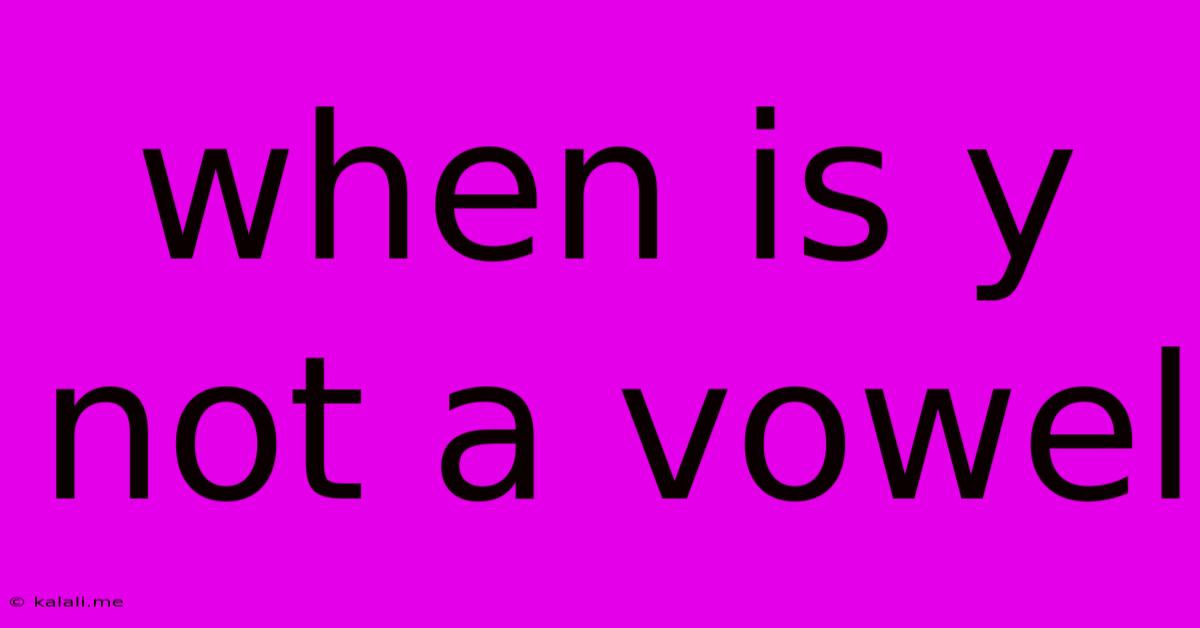When Is Y Not A Vowel
Kalali
Jun 09, 2025 · 2 min read

Table of Contents
When is Y Not a Vowel? The Surprising Truth About Y's Dual Nature
Y is a tricky letter! Sometimes it acts like a vowel, smoothly blending with other letters to create words like "my," "cry," and "sky." Other times, it behaves like a consonant, a hard-hitting sound at the beginning of words like "yellow" or "yoyo." This article will delve into the surprising duality of Y, exploring when it functions as a consonant and when it's happily acting as a vowel.
Understanding the role of Y hinges on its position within a word and its sound. While many learn early on that A, E, I, O, and U are vowels, Y's classification is more nuanced and context-dependent.
Y as a Consonant: The Beginning is Key
Most commonly, Y acts as a consonant when it appears at the beginning of a word or syllable. Think about words like:
- Yellow
- Yarn
- Yacht
- Yes
- Yoyo
In these examples, the Y sound is produced with a consonant-like closure in the vocal tract – a more constricted airflow compared to the open vowels. It's that initial sound that categorizes Y as a consonant in these instances. This also holds true for words where Y starts a syllable, even if it's not at the very beginning of a word, like in "rhythm."
Y as a Vowel: The Middle and End Game
Y switches roles and becomes a vowel when it appears at the end of a syllable or word and produces a vowel sound. Consider these examples:
- My
- Cry
- Sky
- Happy
- Day
Here, the Y acts phonetically as a vowel sound, similar to the "i" sound in "bit" or the "ee" sound in "see". Its sound aligns closely with these vowel sounds and serves the same function phonetically in these words. The positioning within the word and its phonetic role dictates its classification as a vowel.
Exceptions and Nuances: The Grey Areas
Like many aspects of language, there are always exceptions and nuances. The classification of Y can sometimes be ambiguous depending on pronunciation and dialect variations. However, the general rule of thumb remains consistent – position and sound are the primary determinants.
Why Understanding Y's Dual Nature Matters
Understanding the dual nature of Y is crucial for various reasons:
- Spelling and phonics: Recognizing when Y acts as a consonant or a vowel is essential for accurate spelling and phonics instruction, particularly for younger learners.
- Grammar and language analysis: Properly classifying Y is critical for accurate grammatical analysis, part-of-speech identification, and linguistic studies.
- Improved writing and reading skills: Knowing the rules associated with Y's function greatly improves reading and writing comprehension.
In conclusion, the classification of Y as a vowel or consonant isn't arbitrary. It depends entirely on its position within a word and its resulting sound. By understanding these factors, we can appreciate the versatility and interesting linguistic behavior of the letter Y.
Latest Posts
Latest Posts
-
Corrosion On Battery Terminal And Car Wont Start
Jun 09, 2025
-
At What Temperature Does Popcorn Pop
Jun 09, 2025
-
Yellow Light Stopping Probability Logistic Function
Jun 09, 2025
-
Can You Set The Ball In Grass Volleyball
Jun 09, 2025
-
How To Remove A Musty Smell From Basement
Jun 09, 2025
Related Post
Thank you for visiting our website which covers about When Is Y Not A Vowel . We hope the information provided has been useful to you. Feel free to contact us if you have any questions or need further assistance. See you next time and don't miss to bookmark.